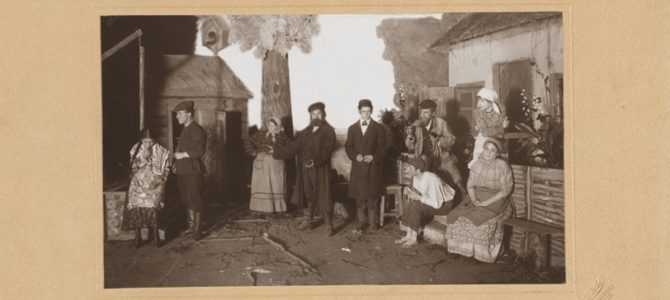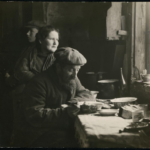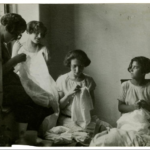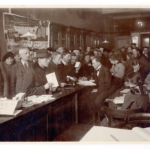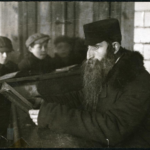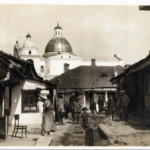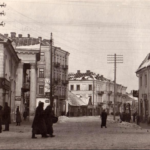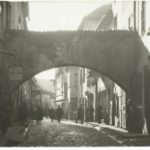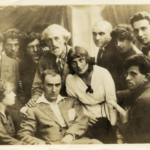Photo: Alter Kacyzne. “Green Fields” theater still. ca. 1921. Museum of the City of New York.
text by Yitskhok Niborski, translated from Yiddish by Yankl Salant
Kacyzne, Alter-Sholem (May 31, 1885-July 7, 1941)
(1885–1941), Yiddish writer and critic; photographer. Born in Vilna to a working-class family, Alter-Sholem Kacyzne (Yid., Katsizne) attended heder and also a Russian-language Jewish elementary school. At 14, after his father’s death, he stopped his formal studies. Kacyzne was an autodidact and remained an avid reader not only of literature in Russian, Yiddish, and Hebrew, but also of Polish, German and French works. For about 11 years he lived in Ekaterinoslav where he learned to be a photographer and was married.
In 1909, Kacyzne first published two Russian stories in the periodical Evreiski mir (Jewish World), edited by S. An-ski. In 1910, attracted by the work and reputation of Y. L. Peretz, Kacyzne settled in Warsaw, where he opened a photography studio. He grew very close to Peretz, who became a literary mentor, but did not begin publishing in Yiddish until after Peretz’s death in 1915. Kacyzne’s first Yiddish texts appeared in collections in Vilna and Kiev. In 1919 and 1920 his first two books were published in Warsaw, the dramatic poems Der gayst der meylekh (The Spirit, the King) and Prometeus (Prometheus). He was also a consistent contributor to (and sometimes co-founder and co-editor of) a series of literary periodicals, most of them short-lived, in Warsaw and Vilna, in which he published novellas and stories that in 1922 appeared in book form as Arabeskn (Arabesques).
Kacyzne maintained a close intellectual friendship with An-ski. After the latter’s death in 1920, Kacyzne edited and completed An-ski’s unfinished play Tog un nakht (Day and Night), a project that pushed him to continue writing for the theater. His play Dukus (Duke), produced in Warsaw in 1925, achieved great success throughout Poland, Romania, and as far as Argentina. It was published as a book in 1926, as was Hurdus (Herod) that same year. Kacyzne also wrote for the Warsaw Literarishe bleter, and for a limited time served as co-editor. There and in other periodicals he regularly published poems, ballads, plays, and articles on literature, art and social topics.
Kacyzne’s career as a photographer reached its turning point in 1921 when the American organization HIAS (Hebrew Immigrant Aid Society) commissioned him to illustrate the misery of Polish Jews who were hoping to immigrate to the United States. Soon after, at the invitation of editor Abraham Cahan, he began to send photographs on a regular basis to the New York Forverts (Forward), which printed them in its Sunday art supplement. Commissioned by the Forverts, Kacyzne traveled with his camera all over Poland, and also to Palestine, Romania, Italy, Spain, and Morocco. Photography became a second area of artistic creativity for him, and it supported his literary work, both economically and thematically.
In the late 1920s, Kacyzne composed his great two-volume novel Shtarke un shvakhe (The Strong and the Weak; 1929–1930). From 1934 to 1935 he was editor-in-chief of the ephemeral Communist-oriented daily Der fraynd (The Friend). In 1936 he published the volume Baladn un groteskn (Ballads and Grotesques). Later he wrote three plays: Dem yidns opere (The Jew’s Opera), Ester (Esther), and Shvartsbard (about Sholem Schwartzbard who assassinated the Ukrainian nationalist Symon Petliura in 1926). The first was not published during his lifetime; the other two were issued between 1937 and 1939 as installments in the periodical Mayn redndiker film (My Talking Film) which Kacyzne published with his own resources (and filled with his own creative writing, memoirs and other articles). Kacyzne also translated from Russian to Yiddish and wrote the screenplay for the film Der dibek (Dybbuk, Poland, 1937) based on An-ski’s play.
Full entry here.


